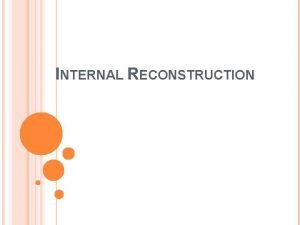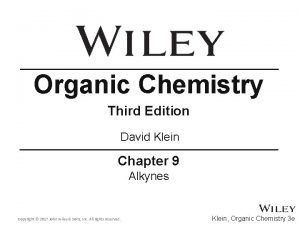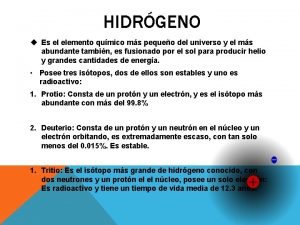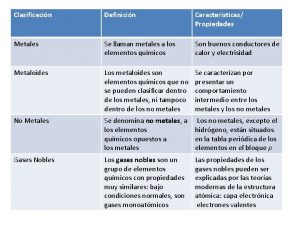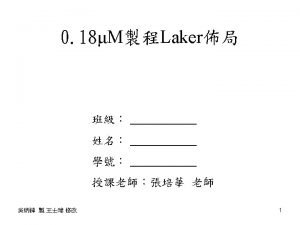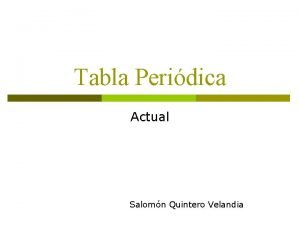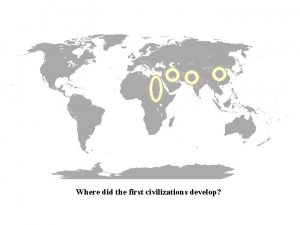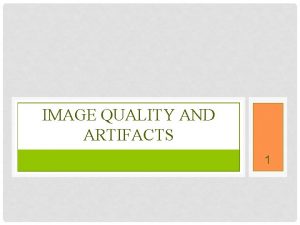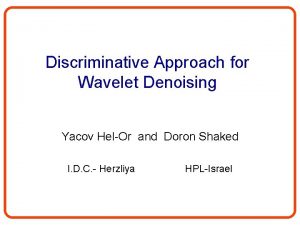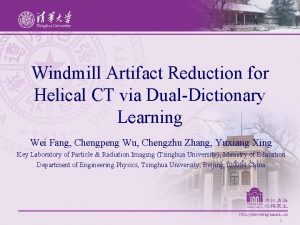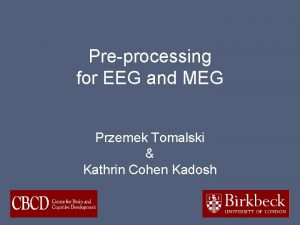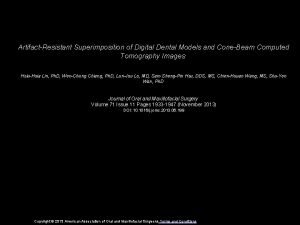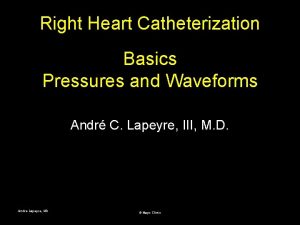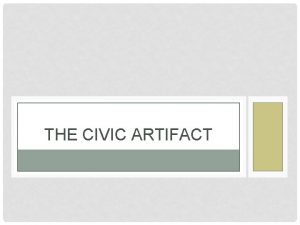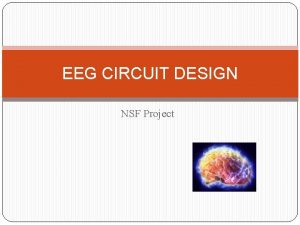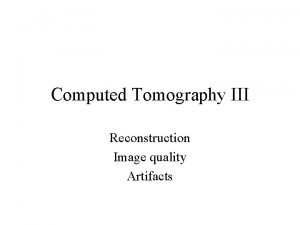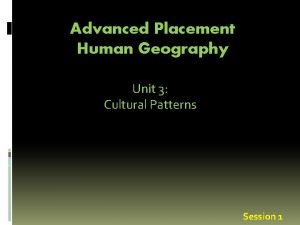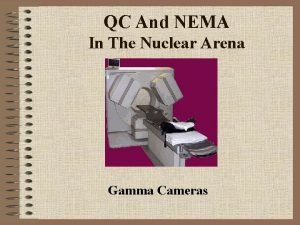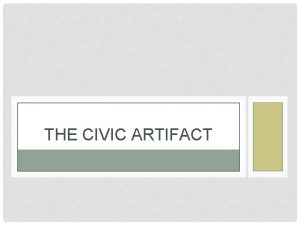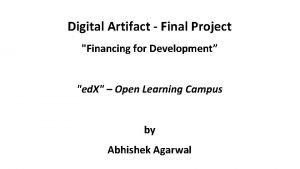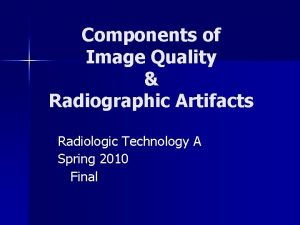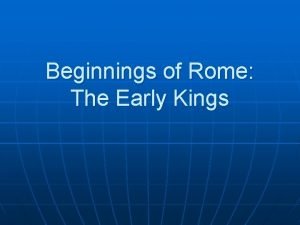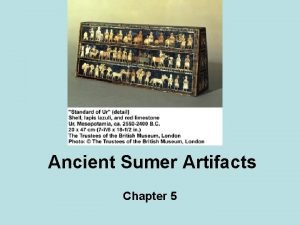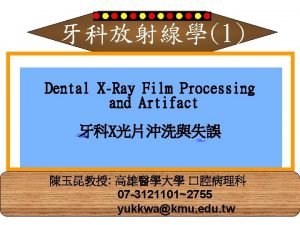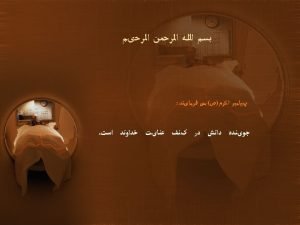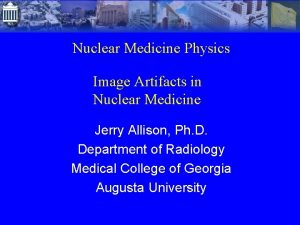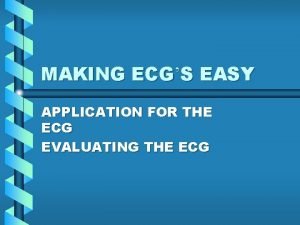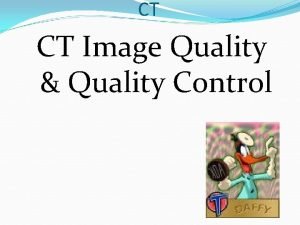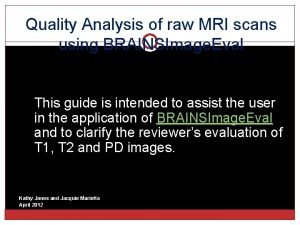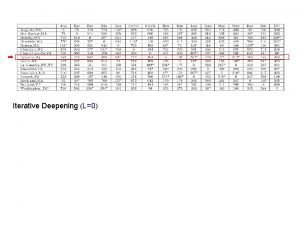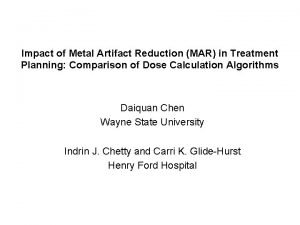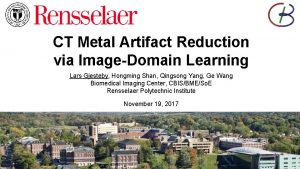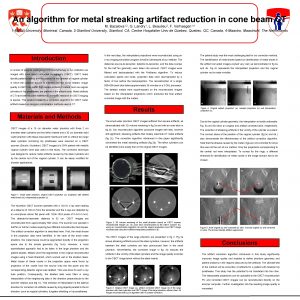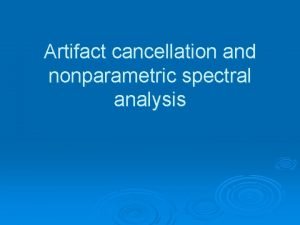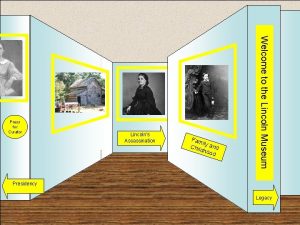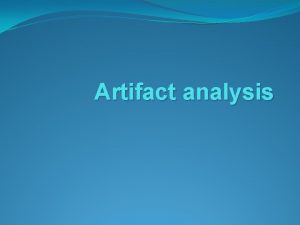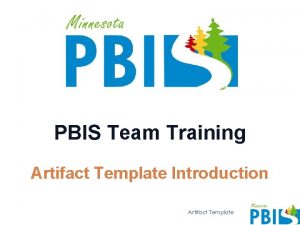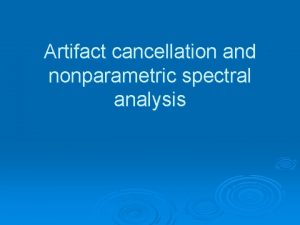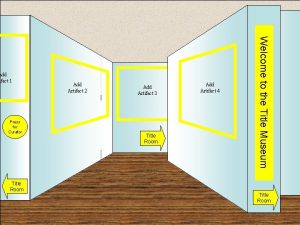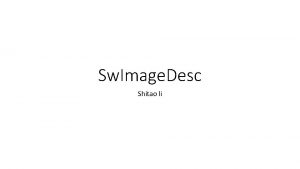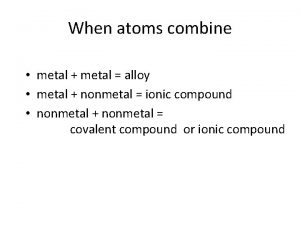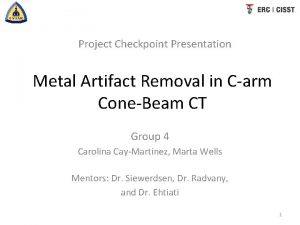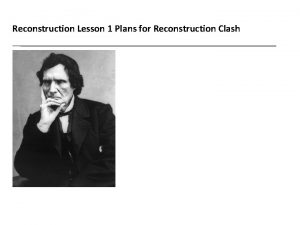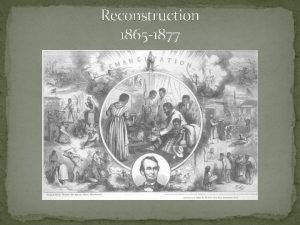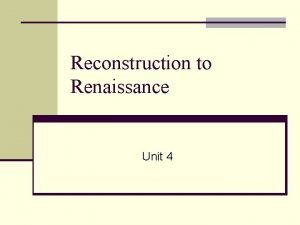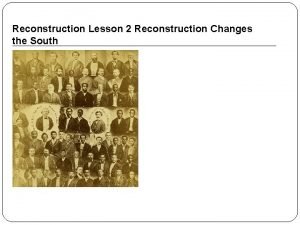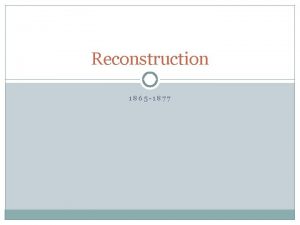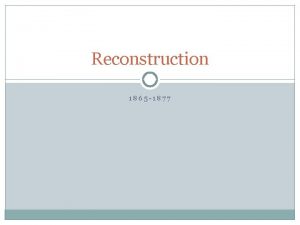Iterative reconstruction for metal artifact reduction in CT





















![MLTR convex algorithm [1] patchwork: local update [2, 3] [1] Lange, Fessler, “Globally MLTR convex algorithm [1] patchwork: local update [2, 3] [1] Lange, Fessler, “Globally](https://slidetodoc.com/presentation_image/4a93b44c644492d4f98c3087d58e1af2/image-22.jpg)








![patches, local models MLTR convex algorithm [1] patchwork: local update [2, 3] [1] Lange, patches, local models MLTR convex algorithm [1] patchwork: local update [2, 3] [1] Lange,](https://slidetodoc.com/presentation_image/4a93b44c644492d4f98c3087d58e1af2/image-31.jpg)












- Slides: 43

Iterative reconstruction for metal artifact reduction in CT • the problem • projection completion • polychromatic ML model for CT • local models, bowtie, … • examples Katrien Van Slambrouck, Johan Nuyts Nuclear Medicine, KU Leuven 1

the problem CT iron y ln(b/y) 2

the problem Double knee prosthesis Double hip prosthesis Dental fillings Cause of metal artifacts: • Beam hardening • Nonlinear partial volume effects • Noise • Scatter • resolution (crosstalk, afterglow) • (Motion) Mouse bone and titanium screw (micro. CT) 3

Artifacts in CT Beam hardening Energy (ke. V) 10 cm water Normalized intensity (%) Polychromatic spectrum, beam hardens when going through the object Low energy photons are more likely absorbed Normalized intensity (%) I. Energy (ke. V) Typical artifact appearance: dark streaks in between metals, dark shades around metals (and cupping) Iron in water Amalgam in PMMA

Artifacts in CT II. (Non)-linear partial volume effects • • Linear: voxels only partly filled with particular substance Non-linear: averaging over beam width, focal spot, … I 0 µ 2 µ 1 I Typical artifact appearance: dark and white streaks connecting edges Iron in water Amalgam in PMMA

Artifacts in CT III. Scatter • • Compton scatter: deviation form original trajectory Scatter grids? I 0 Typical artifact appearance: dark streaks in between metals, dark shades around metals (and cupping) Iron in water Amalgam in PMMA

Artifacts in CT IV. Noise • Quantum nature: ± Poisson distribution Typical artifact appearance: streaks around and in between metals Iron in water Amalgam in PMMA

projection completion Initial FBP reconstruction Segment the metals and project Remove metal projections for sinogram Interpolate (e. g. linear, polynomial, …) Reconstruct (FBP) and paste metal parts • Kalender W. et a. I. "Reduction of CT artifacts caused by metallic impants. " Radiology, 1987 • Glover G. and Pelc N. "An algorithm for the reduction of metal clip artifacts in CT reconstructions. " Med. Phys. , 1981 • Mahnken A. et al, "A new algoritbm for metal artifact reduction in computed tomogrpaby, In vitro and in vivo evaluation after total hip replacement. " Investigative Radiology, 2003 8

projection completion window 600 HU H 2 O PMMA Fe 9

projection completion window 600 HU true object FBP projection completion 10

projection completion 1 2 zeroed metal trace linear interpolation • Muller I. , Buzug T. M. , "Spurious structures created by interpolation-based Ct metal artifact reduction. " Proc. of SPIE, 2009 • Meyer E. et al, "Normalized metal artifact reduction (NMAR) in computed tomography. " Med. Phys. , 2010 11

NMAR window 600 HU sinogram interpolated sinogram of segmentation normalized sinogram • Muller I. , Buzug T. M. , "Spurious structures created by interpolation-based Ct metal artifact reduction. " Proc. of SPIE, 2009 • Meyer E. et al, "Normalized metal artifact reduction (NMAR) in computed tomography. " Med. Phys. , 2010 12

NMAR 1 2 sinogram, metals erased sinogram of the segmented reconstruction 13

NMAR 1 2 normalized sinogram, metals erased interpolated sinogram 14

NMAR unnormalized interpolated sinogram 15

proj. completion and NMAR window 300 HU true object FBP projection completion NMAR 16

Maximum Likelihood for CT CT 17

Maximum Likelihood for CT CT data recon 18

Maximum Likelihood for CT one wishes to find recon that maximizes p(recon | data) data recon computing p(recon | data) difficult inverse problem computing p(data | recon) “easy” forward problem Bayes: p(data | recon) p(recon | data) = ~ p(data) MAP ML 19

Maximum Likelihood for CT p(recon | data) ~ p(data | recon) data recon projection Poisson mj p(data | recon) j = 1. . J i = 1. . I ln(p(data | recon)) =~ L(data | recon) = 20

Maximum Likelihood for CT L(data | recon) iterative maximisation of L: 21
![MLTR convex algorithm 1 patchwork local update 2 3 1 Lange Fessler Globally MLTR convex algorithm [1] patchwork: local update [2, 3] [1] Lange, Fessler, “Globally](https://slidetodoc.com/presentation_image/4a93b44c644492d4f98c3087d58e1af2/image-22.jpg)
MLTR convex algorithm [1] patchwork: local update [2, 3] [1] Lange, Fessler, “Globally convergent algorithms for maximum a posteriori transmission tomography”, IEEE Trans Image Proc, 1995 [2] JA Fessler et al, "Grouped-coordinate ascent algorithm for penalized likelihood transmission image reconstruction. " IEEE Trans Med Imaging 1997. [3] Fessler, Donghwan, "Axial block coordinate descent (ABCD) algorithm for X-ray CT image reconstruction. “ Fully 3 D 2011 22

MLTR MEASUREMENT COMPARE UPDATE RECON REPROJECTION 23

MLTR validation Siemens Sensation 16 Siemens MLTR 24

models for iterative reconstruction Poisson Likelihood: measured data bi data computed from current reconstruction image Projection model: • monochromatic: 25

models for iterative reconstruction Poisson Likelihood: intensity bik measured data computed from current reconstruction image Projection model: energy k • monochromatic: • 1 material polychromatic: MLTR_C “water correction” energy 26

models for iterative reconstruction Poisson Likelihood: intensity bik Projection model: • Full Polychromatic Model – IMPACT energy k 27

models for iterative reconstruction • Full Polychromatic Model – IMPACT al water attenuation Compton photo-electric mjk = photo-electric + Compton at energy k mjk = fj ∙ photok + qj ∙ Comptonk = Klein-Nishina (energy) Photok ≈ 1 / energy 3 28

models for iterative reconstruction • Full Polychromatic Model – IMPACT F and q (1/cm) f mjk = fj ∙ photok + qj ∙ Comptonk q mjk = f(mj)∙ photok + q(mj) ∙ Comptonk mmono (1/cm) 29

models for iterative reconstruction F and q (1/cm) f q mmono (1/cm) 30
![patches local models MLTR convex algorithm 1 patchwork local update 2 3 1 Lange patches, local models MLTR convex algorithm [1] patchwork: local update [2, 3] [1] Lange,](https://slidetodoc.com/presentation_image/4a93b44c644492d4f98c3087d58e1af2/image-31.jpg)
patches, local models MLTR convex algorithm [1] patchwork: local update [2, 3] [1] Lange, Fessler, “Globally convergent algorithms for maximum a posteriori transmission tomography”, IEEE Trans Image Proc, 1995 [2] JA Fessler et al, "Grouped-coordinate ascent algorithm for penalized likelihood transmission image reconstruction. " IEEE Trans Med Imaging 1997. [3] Fessler, Donghwan, "Axial block coordinate descent (ABCD) algorithm for X-ray CT image reconstruction. “ Fully 3 D 2011 31

bowtie, BHC intensity bik e- energy k • raw CT data not corrected for beam hardening • send spectrum through filter and bowtie bik = spectrum(k) x bowtie(i) 32

patches, local models IMPACT is complex and slow, MLTR and MLTR_C are simpler and faster PATCH 3 Find the metals Define patches IMPACT in metals MLTR_C elsewhere PATCH 2 PATCH 4 PATCH 1 33

clinical CT (Siemens Sensation 16) Body shaped phantom 34

sequential CT (Siemens Sensation 16) Body shaped phantom FBP Regular PC PC NMAR IMPACT PATCH MLTR_C + IMPACT 20 iter x 116 subsets 35

sequential CT (Siemens Sensation 16) Body shaped phantom Ti Al V Co. Cr. . water aluminum PMMA water Black = FBP Blue = PC-NMAR Red = IMPACT PATCH 36

helical CT sequential 2 x 1 mm helical 16 x 0. 75 mm 37

helical CT MIP metal patches, uniform init. FBP IMPACT no patches, NMAR init. NMAR metal patches, NMAR init. 5 iter x 116 subsets 38

helical CT MIP metal patches, uniform init. FBP IMPACT no patches, NMAR init. NMAR metal patches, NMAR init. 39

helical CT FBP NMAR IMPACT 10 it 5 it 40

helical CT We give patches same x-y sampling but increased z-sampling: impact, regular z z-sampling x 3 41

to do • after 5. . 10 x 100 iterations with patches still incomplete convergence • persistent artifacts near flat edges of metal implants • we currently think it is not o scatter o non-linear partial volume effect o crosstalk, afterglow o detector dead space 42

better physical model better reconstruction Katrien Van Slambrouck Bruno De Man Karl Stierstorfer, David Faul, Siemens thanks 43
 Alteration of share capital
Alteration of share capital Alkyne to alkene
Alkyne to alkene El sodio es metal o no metal
El sodio es metal o no metal Metals used
Metals used Blanch def
Blanch def Periodic trends acidity
Periodic trends acidity Liquid elements at room temperature
Liquid elements at room temperature Características de los metales y no metales
Características de los metales y no metales Difference between metal oxides and non metal oxides
Difference between metal oxides and non metal oxides Metals react with nonmetals to form ionic compounds by
Metals react with nonmetals to form ionic compounds by Venn diagram of conduction, convection and radiation
Venn diagram of conduction, convection and radiation Reactivity periodic table
Reactivity periodic table Deep nwell
Deep nwell P
P Metals vs nonmetals vs metalloids
Metals vs nonmetals vs metalloids Cuneiform alphabet
Cuneiform alphabet Sketch a key artifact relating to david
Sketch a key artifact relating to david Double exposure xray
Double exposure xray Artifact
Artifact Terrior definition ap human geography
Terrior definition ap human geography Windmill artifact ct
Windmill artifact ct Eeg sweat artifact
Eeg sweat artifact Artifact
Artifact Superimposition artifact
Superimposition artifact Catheter whip artifact
Catheter whip artifact Civic artifacts
Civic artifacts Significant artifact
Significant artifact Eeg circuit
Eeg circuit Partial volume artifact
Partial volume artifact Distance decay ap human geography
Distance decay ap human geography Range ambiguity artifact
Range ambiguity artifact Paleolithic era toolkit
Paleolithic era toolkit Orthogonal hole phantom
Orthogonal hole phantom Civic artifact
Civic artifact Digital artifact project
Digital artifact project Kink marks artifact
Kink marks artifact Artifact wiki
Artifact wiki Was ancient sumer a civilization chapter 5
Was ancient sumer a civilization chapter 5 X-ray film processing
X-ray film processing Partial volume artifact ct
Partial volume artifact ct Diaphragm
Diaphragm Somatic tremor artifact
Somatic tremor artifact Ct wimage
Ct wimage Moire artifact mri
Moire artifact mri
